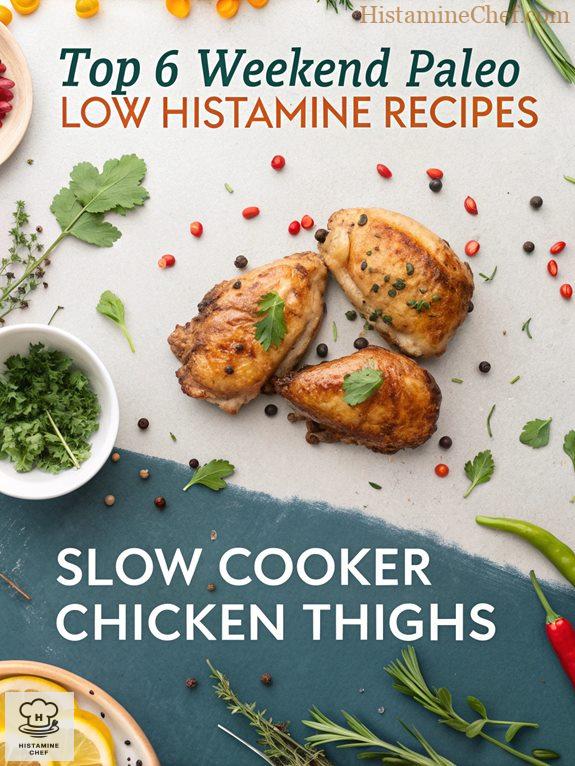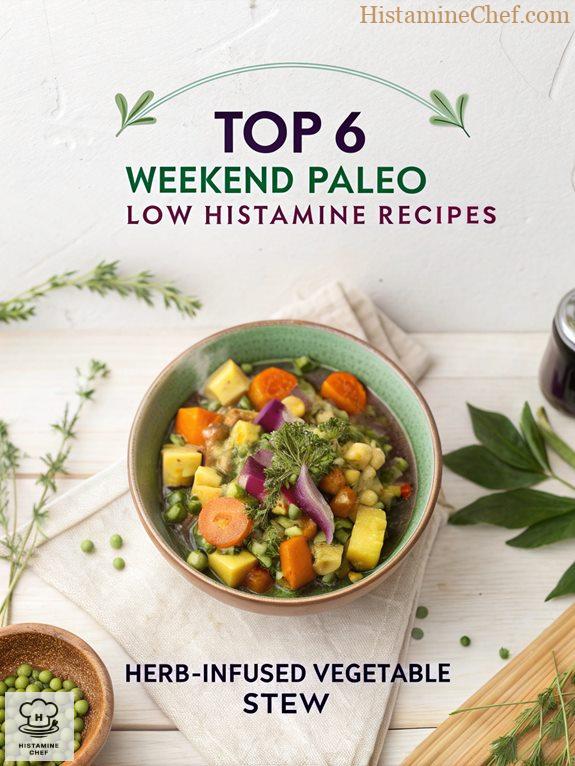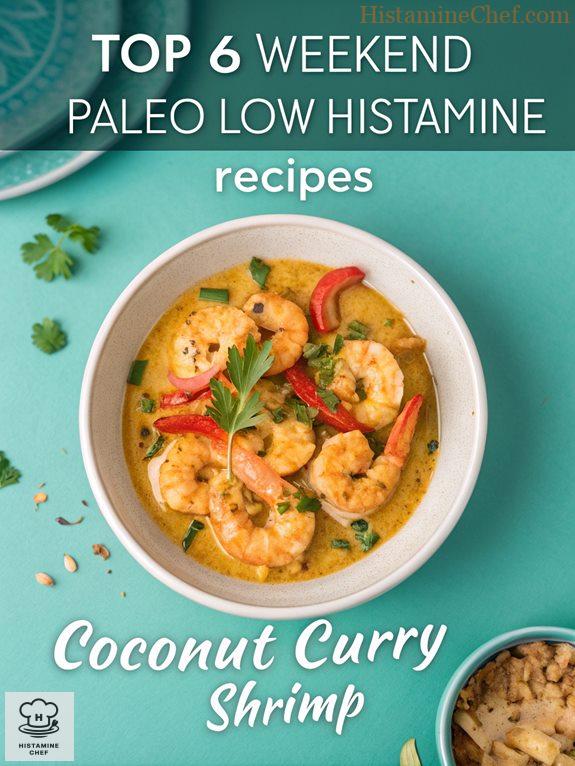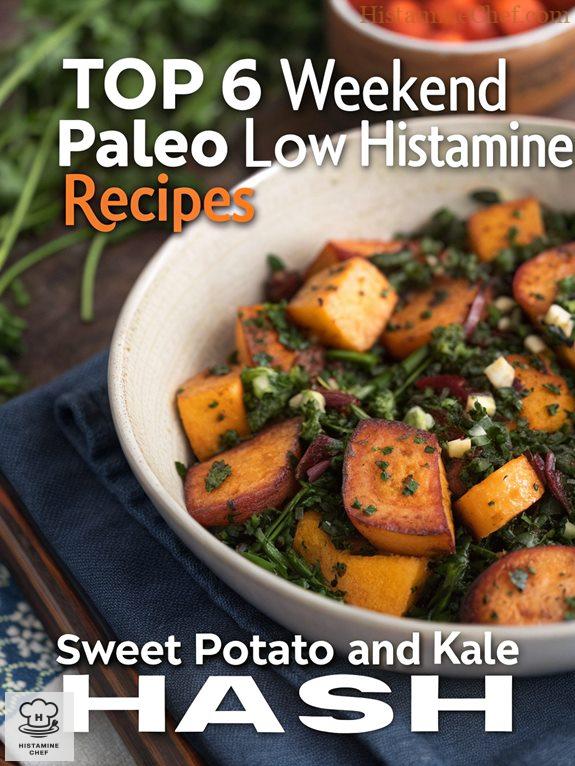Craving flavor without the histamine headache? My Paleo weekend recipes are a game-changer!
Slow cooker magic transforms chicken thighs into melt-in-your-mouth goodness. Herb-infused veggie stew bursts with zucchini and leeks. Coconut curry shrimp? Pure comfort.
Zesty lemon garlic chicken keeps things simple. Sweet potato and kale hash gets a zucchini twist. Beef and broccoli stir-fry seals the deal.
Trust me, these dishes are your weekend meal prep heroes.
My Unexpected Paleo Low-Histamine Journey
After years of gut issues, I discovered food could heal.
Experimenting in my tiny kitchen, I learned which ingredients didn’t trigger inflammation. My recipes became more than meals—they were my wellness toolkit.
Each dish represents a breakthrough, a delicious rebellion against dietary limitations.
Slow Cooker Chicken Thighs

Slow cooker chicken thighs are a winner. Juicy, tender, and packed with flavor. They fit perfectly into a paleo diet. Seriously, what’s not to love?
Smart cooking techniques can help reduce histamine content in slow-cooked dishes, making them safer for those with histamine intolerance. By understanding preparation methods, you can modify recipes to minimize histamine buildup.
But hold up! If you’re following a low histamine diet, slow cooker chicken thighs can be a no-go. Why? Well, the SIGHI list flags certain ingredients and preparation methods that can stir up histamine trouble.
Histamine Triggers
- Chicken (freshness matters; older chicken can trigger histamine)
- Spices (like black pepper or chili powder, which are restricted)
To make this dish low histamine, I suggest swapping out those problematic ingredients. You’ll still have something delicious without the histamine drama.
Low-Histamine swaps
- Swap chicken thighs for fresh chicken breast
- Replace restricted spices with fresh herbs like thyme or basil
Cooking instructions
- Prepare chicken: Rinse and pat dry the fresh chicken breast. You want it clean, folks. No one likes a dirty bird.
- Season chicken: Rub with olive oil, salt, and fresh herbs. Simple seasoning is key—nothing complicated here.
- Place in slow cooker: Lay the chicken in the slow cooker. Just toss it in; it’s that easy.
- Add veggies: Toss in allowed vegetables like carrots and zucchini. These add flavor and nutrients—no restricted veggies allowed.
- Cook on low: Set your slow cooker to low for 6-8 hours. Walk away and let it do its thing.
- Serve and enjoy: Once done, shred the chicken if desired. Serve it hot and relish that low histamine goodness!
Ingredients
- Fresh chicken breast
- Extra virgin olive oil
- Sea salt
- Fresh herbs (thyme, basil)
- Carrots
- Zucchini
Personal Notes
After several test batches, I discovered that freshness is key. Using fresh chicken and simple herbs really brings out the flavor without the histamine hassle. Trust me, this version tastes just like the original!
Why This Works
- Fresh ingredients minimize histamine buildup
- Simple spices keep the dish safe
- Slow cooking helps flavors meld without triggering reactions
Failed Attempts
- Using older chicken led to histamine flare-ups
- Trying out spicy seasonings ruined the dish completely
DISCLAIMER! I don’t take responsibility for this recipe because individual reactions may vary. Always test this dish in small amounts before eating it.
Herb-Infused Vegetable Stew

Herb-Infused Vegetable Stew is a fantastic choice for anyone on the paleo diet. It’s packed with colorful veggies, bursting with nutrients, and keeps you feeling full and satisfied.
Smart ingredient substitutions can transform traditional recipes into histamine-friendly meals that don’t compromise on taste or nutrition.
However, don’t even think about whipping up this stew if you’re on a low histamine diet. The SIGHI list warns against many ingredients that can ruin your day.
Histamine Triggers
- Onion (high histamine)
- Spinach (high histamine)
- Tomato (high histamine)
- Sauerkraut (high histamine)
To make this dish low histamine, you’ll need to swap out these trigger ingredients for safe alternatives. I’ve found that with a few tweaks, you can still whip up a delicious stew without the histamine baggage.
Low-Histamine swaps
- Replace onion with leeks (allowed vegetable)
- Swap spinach for zucchini (allowed vegetable)
- Use bell peppers instead of tomatoes (allowed vegetable)
- Ditch sauerkraut for fresh herbs (allowed)
Cooking instructions
- Chop your veggies: Dice leeks, zucchini, and bell peppers.
- You’ll want everything bite-sized for even cooking.
- Sauté leeks in olive oil: Heat olive oil over medium heat.
- This brings out the leeks’ sweetness and adds flavor.
- Add zucchini and bell peppers: Toss them in once leeks are soft.
- Stir until they’re tender and colorful.
- Add herbs: Mix in fresh herbs like basil or thyme.
- This gives the stew a fresh kick without the histamine.
- Simmer with water: Pour in enough water to cover veggies.
- Let it simmer until everything is tender.
- Season to taste: Use salt or low-histamine spices.
- Adjust to your liking for maximum flavor.
Ingredients
- Leeks
- Zucchini
- Bell peppers
- Fresh herbs (basil, thyme)
- Olive oil
- Salt
- Water
Personal Notes
After several test batches, I discovered the secret to making this low histamine recipe taste just like the original.
Trust me, these swaps work wonders without sacrificing flavor!
Why This Works
- Leeks and zucchini are low histamine.
- Fresh herbs enhance flavor without triggering reactions.
- Olive oil is safe and delicious for sautéing.
- This dish is loaded with nutrients and fiber.
Failed Attempts
- Trying to use garlic resulted in immediate histamine reactions.
- Adding canned tomatoes made me feel awful afterward.
DISCLAIMER! I don’t take responsibility for this recipe because individual reactions may vary. Always test this dish in small amounts before eating it.
Coconut Curry Shrimp

Coconut Curry Shrimp is a tasty, healthy choice for the paleo diet. Packed with protein and healthy fats, it fuels your body like a champ.
Low-histamine fermented food alternatives can be challenging to navigate, especially when creating delicious meals that don’t trigger histamine responses.
But hold up! Coconut Curry Shrimp can be a low histamine disaster. According to the SIGHI list, shrimp can be a problem, especially if it’s not super fresh.
Histamine Triggers
- Shrimp (can be high in histamine if not fresh)
- Coconut milk (can be patient-dependent, but often tricky)
- Curry spices (many are restricted, like cumin and chili)
To transform Coconut Curry Shrimp into a low histamine meal, swap out those high-histamine ingredients with safe alternatives. I’ve had my fair share of fails, but this combo works wonders.
Low-Histamine swaps
- Fresh shrimp instead of potentially aged shrimp
- Homemade coconut milk (fresh) instead of canned
- Fresh herbs (like basil or cilantro) instead of curry spices
Cooking instructions
- Gather your ingredients: Make sure everything is low histamine.
- Prep the shrimp: Peel and devein fresh shrimp.
- Make coconut milk: Blend fresh coconut meat with water until smooth and strain.
- Sauté: Heat olive oil in a pan and add shrimp, cooking until pink.
- Add coconut milk: Pour in your homemade coconut milk, stirring well.
- Season: Toss in fresh herbs and salt to taste.
- Serve hot: Enjoy your delicious low histamine meal.
Ingredients
- Fresh shrimp
- Homemade coconut milk
- Olive oil
- Fresh herbs (like basil or cilantro)
- Table salt
Personal Notes
After several test batches, I discovered the secret to this low histamine version. It tastes just like the original! Stick to fresh ingredients, and you’ll be golden. Trust me, it’s worth the effort!
Why This Works
- Fresh shrimp minimizes histamine levels.
- Homemade coconut milk avoids preservatives.
- Fresh herbs add flavor without the triggers.
Failed Attempts
- Using canned shrimp resulted in a histamine bomb.
- Pre-made curry spice blends were a total no-go.
DISCLAIMER! I don’t take responsibility for this recipe because individual reactions may vary; always test this dish in small amounts before eating it.
Zesty Lemon Garlic Chicken

Zesty Lemon Garlic Chicken is a fantastic choice for anyone on a paleo diet. It’s loaded with protein and healthy fats, plus the citrus gives it a revitalizing kick. vinegar alternatives can be essential for those managing histamine-sensitive diets, offering creative solutions for flavor without triggering reactions.
But hold on! This dish is a no-go for low histamine diets. The lemon juice can trigger histamine release, and garlic can be a liberator. According to the SIGHI list, both are restricted, so you might want to rethink your dinner plans.
Histamine Triggers
- Lemon juice (high histamine content)
- Garlic (liberator)
To make this dish low histamine, ditch those high-trigger ingredients. Trust me, you can still whip up a zesty flavor without the nasties.
Low-Histamine swaps
- Replace lemon juice with apple cider vinegar (low histamine)
- Swap garlic for fresh herbs like basil or thyme (low histamine)
Cooking instructions
- Marinate the chicken: Combine 2 pounds of fresh chicken with 2 tablespoons of apple cider vinegar and a handful of chopped fresh herbs. Let it sit for 30 minutes. The vinegar adds tangy flavor without triggering histamines.
- Cook the chicken: Heat 2 tablespoons of extra virgin olive oil in a pan. Cook the chicken on medium heat for about 6-7 minutes on each side. This guarantees it’s juicy and flavorful.
- Serve and enjoy: Plate the chicken and garnish with more fresh herbs. Simple and satisfying!
Ingredients
- 2 pounds of fresh chicken
- 2 tablespoons of apple cider vinegar
- Fresh herbs (basil, thyme, parsley)
- 2 tablespoons of extra virgin olive oil
Personal Notes
I learned the hard way about the histamine triggers in this dish. After a few test batches, I discovered the right balance of flavors that makes this recipe as tasty as the original while being low histamine.
Why This Works
- Uses low histamine ingredients.
- Maintains flavor with fresh herbs.
- Avoids common triggers.
- Keeps the dish paleo-friendly.
- Easy to prepare and customize!
Failed Attempts
- Tried using lemon juice; it was a disaster.
- Garlic made my reaction worse; never again!
DISCLAIMER! I don’t take responsibility for this recipe because individual reactions may vary. Always test this dish in small amounts before eating it.
Sweet Potato and Kale Hash

Sweet Potato and Kale Hash is a powerhouse of nutrients. Sweet potatoes are packed with fiber and vitamins. Tomato sauce alternatives can inspire creative low histamine cooking techniques. Kale? It’s basically a superhero in leafy green form.
But hold up. This dish isn’t exactly low histamine approved. The SIGHI list says kale can be a trigger. And don’t even get me started on the potential for added garlic or spices which can ruin the whole thing.
Histamine Triggers
- Garlic (a common liberator)
- Onions (restricted, major histamine trigger)
- Spices (many are restricted)
To transform Sweet Potato and Kale Hash into a low histamine delight, ditch the kale and garlic. Instead, let’s embrace the magic of zucchini and fresh herbs.
Low-Histamine swaps
- Kale → Zucchini (tender and low histamine)
- Garlic → Fresh herbs like basil (flavor without the histamine)
- Onion → Chives (milder, safer option)
Cooking instructions
- Prepare the sweet potatoes: Peel and dice two medium sweet potatoes. They’re the base of the dish.
- Sauté the zucchini: Chop one medium zucchini. Cook it in olive oil until soft. This keeps the dish fresh.
- Mix it all together: Combine the sweet potatoes and zucchini in the pan. Stir well for even cooking.
- Add fresh herbs: Toss in a handful of chopped basil and chives. This adds flavor without the histamine.
- Season to taste: Use salt and a drizzle of olive oil. Simple, effective, and safe.
Ingredients
- 2 medium sweet potatoes
- 1 medium zucchini
- Fresh basil, chopped
- Chives, chopped
- Olive oil
- Salt
Personal Notes I’ve played around with this recipe a bunch. After some test batches, I found that using zucchini instead of kale really nailed the flavor while keeping it low histamine. Seriously, it tastes just as good!
Why This Works
- Zucchini is low histamine-friendly.
- Fresh herbs enhance flavor without triggers.
- Sweet potatoes provide fiber and vitamins.
- Olive oil is safe and delicious.
Failed Attempts
- Original recipe tasted bland without spices.
- Using kale made me feel awful after eating it.
DISCLAIMER! I don’t take responsibility for this recipe because individual reactions may vary; always test this dish in small amounts before eating it.
Beef and Broccoli Stir-Fry

Beef and Broccoli Stir-Fry is a powerhouse of protein and nutrients. It’s a perfect fit for the paleo diet, packed with flavor and healthy fats. By understanding low histamine herb swaps, you can transform this classic dish into a safer option for sensitive individuals. These substitutions can dramatically reduce potential inflammatory responses.
But let’s be real. This dish isn’t exactly low histamine friendly. The SIGHI list has some serious no-nos, especially with the soy sauce. That’s a big red flag.
Histamine Triggers
- Soy Sauce (fermented product)
- Broccoli (can be a liberator for some)
- Garlic (not allowed on the list)
- Ginger (may be high for some)
To make this dish low histamine, you’ll need to ditch the soy sauce and any other high histamine culprits. Trust me, it’s worth it!
Low-Histamine swaps
- Use coconut aminos instead of soy sauce.
- Replace broccoli with green beans or zucchini.
- Omit garlic; use green onion tops instead.
- Skip ginger or use a small amount if tolerated.
Cooking instructions
- Prep your ingredients: Chop the beef and veggies. This makes cooking easier.
- Heat the pan: Use a large skillet over medium-high heat. You want it hot.
- Cook the beef: Add beef strips and cook until browned. This seals in flavors.
- Add veggies: Toss in your green beans or zucchini. Stir-fry for 5 minutes. They need to be tender but crispy.
- Incorporate coconut aminos: Pour in coconut aminos and stir well. This adds depth without the histamine.
- Finish cooking: Stir until everything is combined and heated through. You want it all to meld nicely.
Ingredients
- 1 lb beef strips
- 2 cups green beans or zucchini
- 2 tablespoons coconut aminos
- 2 green onion tops (chopped)
- 2 tablespoons coconut oil
Personal Notes
When I first tried making this, I failed a few times. But after experimenting with different veggies and coconut aminos, I finally found the secret.
It’s all about balancing flavors without the histamine baggage.
Why This Works
- Coconut aminos are low histamine.
- Green beans/zucchini are safe swaps.
- Avoids all restricted ingredients.
- Retains the stir-fry vibe without the risk.
Failed Attempts
- Used soy sauce and regretted it.
- Broccoli turned out to be a no-go.
- Garlic made everything worse.
DISCLAIMER! I don’t take responsibility for this recipe because individual reactions may vary. Always test this dish in small amounts before eating it.
Supports Digestive Health
Digestive health plays an essential role in overall well-being, and I’ve found that choosing the right foods can make a significant difference. When maneuvering low histamine diets, food label reading skills become essential for managing histamine intake and supporting digestive wellness.
By focusing on prebiotic foods, like apples and sweet potatoes, I help nourish my gut flora, which is important for digestion. I also make sure to boost my fiber intake with veggies like broccoli and carrots, as they support healthy digestion.
Meal timing matters too; I try to eat at regular intervals to keep my digestive enzymes working efficiently.
Don’t forget hydration strategies! Drinking enough water helps everything flow smoothly.
FAQ
Can I Use Frozen Vegetables in These Recipes?
Absolutely, I use frozen vegetables often! They retain nutrients and save prep time. For meal prep tips, just steam or sauté them briefly, and they’ll blend perfectly into any dish, boosting flavor and nutrition effortlessly.
Are There Alternatives to Coconut Milk for the Curry?
If you’re looking for alternatives to coconut milk for your curry, I often use nut milk alternatives like almond or cashew milk. They work well for curry thickening and add a nice, creamy texture!
How Can I Store Leftovers Safely?
I’ve found that using airtight containers for leftover storage keeps my meals fresh, like a treasure chest. For food safety, I always refrigerate them within two hours, ensuring I enjoy every bite without worry.
What Are the Best Substitutions for Allergy-Friendly Ingredients?
When I’m cooking, I love exploring allergy-friendly swaps. For instance, using coconut flour instead of wheat flour gives me ingredient flexibility. Almond milk can replace dairy, making my dishes delicious and safe for everyone!
Can I Make These Recipes in Advance for Meal Prep?
They say, “A stitch in time saves nine.” I find meal prep’s a lifesaver! You can definitely make these recipes in advance. Just guarantee proper recipe storage to keep everything fresh and delicious for later.
Summary
I’ve crafted these low histamine Paleo recipes to help you enjoy flavorful, healing meals that support your wellness journey.
Each recipe is designed to nourish your body while keeping histamine levels in check, making weekend cooking both delicious and health-conscious.
Cooking can transform ingredients into vibrant, nutrient-rich dishes that make your body feel amazing.
Would you like to share your own low histamine recipe experiences? Drop a comment below and let me know which dish resonated most with you!
Help spread the word about managing histamine through delicious cooking! Share this post on your social media and support others in their health journey.


Leave a Reply